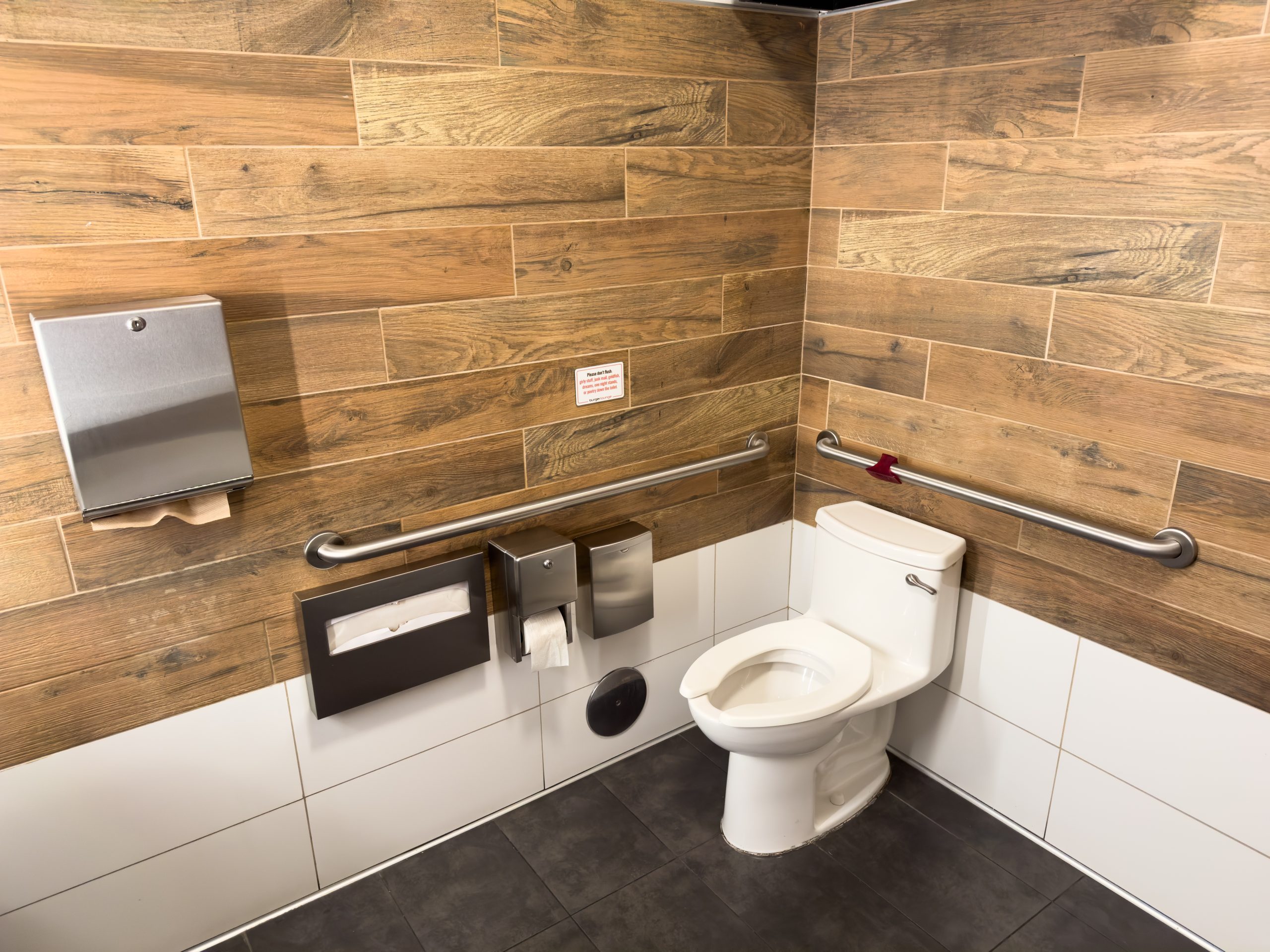Your Ultimate Guide to ADA Stall Layout Success

Designing ADA stall layout public restroom blueprints that coherently comply with the Americans with Disabilities Act is a delicate balance. Whether it’s a spacious toilet stall space or a thoughtfully positioned dispenser, every element plays an important role.
Just as placement isn’t arbitrary, as it dictates the flow and functionality of the entire space, creating an ADA-compliant bathroom goes beyond simply meeting regulations. It begins with stepping into the shoes of your users, particularly individuals who use wheelchairs. They need extra room as they journey through your public space and interact with fixtures appropriately and conveniently.
At the end of the day, there should be ample stall space for wheelchairs to turn and navigate, and every inch of the restroom should be utilized efficiently. Accessible stalls and sinks is a strategic decision, catering to all users. While situating a wheelchair-accessible stall at the restroom’s far end might technically comply with ADA, it may not be the most user-friendly option.
You should also avoid rigid layouts. Instead, aim for a design accommodating future modifications without major overhauls. The goal is a bathroom that’s not merely ADA compliant, but truly welcoming and inclusive.
ADA compliance is an ongoing process. As guidelines and user needs evolve, your organization’s public restroom must adapt. Standards offer a framework, but exceptional design surpasses the bare minimum, focusing on experiential value and comfort.
Overall, it’s about smart space utilization, thoughtful fixture placement, and future flexibility. When you achieve this balance, you create stall spaces and public restrooms that aren’t just functional; they embody respect and dignity for everyone who enters.
America, ADA Stall Layout, and Public Spaces
A truly accessible ADA stall layout restroom prioritizes space as a fundamental design principle. It recognizes that freedom of movement is essential for everyone.
The Americans with Disabilities Act sets a minimum door width of 32 inches, ensuring wheelchair users can enter without difficulty. Inside, a spacious turning radius of at least 60 inches allows for effortless maneuvering and eliminates confinement.
“Imagine being in a confined space, without room to turn or position yourself comfortably,” states a column in RestoBiz. “For wheelchair users, maneuvering within conventional restrooms can be akin to navigating a maze.”
The ADA represents a profound shift in societal perspective. It celebrates human diversity and fosters inclusion for individuals using public restrooms who have all types of conditions.
Understanding disability requires a multi-faceted approach. In fact, each type of disability spotlights a unique aspect of a more complex reality for every individual. Recognizing these strengths and limitations is crucial to informing disability law and ongoing regulatory policies.
The ADA’s enactment marked a turning point in engagement between local communities, businesses, organizations, public places, and consumers. It ushered in an era dedicated to building a society where everyone, regardless of ability, has the opportunity to thrive while using restroom facilities.
“To imagine America without the ADA is to envision unrelenting segregation and marginalization,” states Syracuse University’s Burton Blatt Institute, as quoted in the Journal of Disability Policy Studies. “The ADA is anchored firmly in the idea of ‘personhood,’ as reflected in individual inherent worth, autonomy, and self-determination, to the maximum extent possible, with natural supports and accommodations within reason.”
Nonetheless, facility managers updating their restrooms encounter a labyrinth of legal and regulatory requirements. These include accessibility rules under the ADA and safety policies under the Occupational Safety and Health Act (OSHA).
ADA Regulatory Requirements: A Web of Compliance
Designing a public restroom comes down to navigating a quagmire of regulations, from ensuring ADA stall layout accessibility to conserving water. It’s about creating a space that’s both functional and welcoming.
Even after decades of the ADA in play, ensuring a restroom is compliant remains a challenge:
- Dispensers: Seemingly minor oversights like a misplaced soap dispenser can create real obstacles for users.
- Design: A misplaced baby changing table or an uninsulated pipe can become a serious issue.
- Efficiency: There’s growing pressure to save water. With rising costs and environmental concerns, efficient fixtures are a must in 2024 and beyond. Even the best toilet won’t help if it’s installed incorrectly or poorly maintained.
- Leaks: A leaky faucet or a misaligned flushometer can waste gallons of water and negate any potential savings. A small leak might seem trivial, but it can lead to major water waste and even structural damage.
- Maintenance: Regular inspections and prompt repairs are essential. Maintenance staff also need to be trained to spot potential ADA issues.
In one recent FacilitiesNet bathroom layout example, an experts says: “A baby changing table needs to be installed where there is proper clear floor space to use it, but also not to obstruct access to the water closet by installing it in the accessible toilet stall because of the extra space available.”
Many ADA features need to be mirrored in each gender’s restrooms, he notes. If the women’s restroom has a changing table, then the men’s room also needs one.
“Unisex toilet rooms, sometimes referred to as family restrooms, also must have all ADA accessibility features, even if you provide accessible toilet facilities in the men’s and ladies’ restrooms,” he says.
By prioritizing accessibility, and by undergoing routine maintenance, today’s facility managers can create restrooms that are compliant and welcoming.
Designing a Law-Abiding ADA Stall Layout for Success
With the right assistance, you can prioritize minimums and maneuverability when adhering to ADA stall layout dimensions, as well as specifications for clear floor space and fixtures. Strategically placed fixtures and accessories at ADA-compliant heights benefit everyone.
Clear floor space under fixtures dominate some of the top ADA-compliant bathrooms across the nation. This ensures wheelchair and other users can approach sinks, toilets, and essentials with ease.
However, beyond simply meeting legal requirements, a thoughtfully designed ADA-compliant bathroom can be a powerful business differentiator. Partnering with professional manufacturers and designers allows you to craft a customized layout that not only maximizes accessibility but optimizes space, elevating the overall aesthetic of your restroom environment.
You can also avoid costly mistakes and legal pitfalls, as the financial and reputational risks of non-compliance are huge. With potential penalties reaching $150,000, it’s clear that ADA compliance is good practice and a legal necessity. Fortunately, professional designers can guide you through the intricacies of ADA regulations, safeguarding your organization against expensive mistakes and guaranteeing peace of mind.
A provider that can design, engineer, and manufacture fixtures and appliances is an invaluable ally. A partner’s expertise ensures your ADA bathroom floor plans are compliant and tailored to your specific needs and space constraints. This holistic approach streamlines the process, eliminates guesswork, and guarantees a functional and aesthetically pleasing result.
Investing in professional ADA bathroom design is a strategic move that yields multiple benefits. You avoid legal headaches, create a welcoming environment for all customers, and potentially gain a competitive edge in your business.
Partner with the Right ADA-Compliant Solutions Provider
Creating a compliant ADA stall layout or restroom can feel like you’re traversing uncharted territory. Thankfully, partnering with a specialized manufacturer is like having a seasoned guide by your side.
These manufacturers, well-versed in the intricacies of ADA standards, offer compliant products and bring a wealth of expertise and support:
- Past clients: When selecting a manufacturer, their portfolio can be a testament to their experience. A history of producing ADA-compliant fixtures demonstrates an understanding of standards and ability to blend compliance with functionality and aesthetics. It’s a reassuring sign they can help you choose the right products for enhancing accessibility and user experience.
- Advice: Beyond product offerings, a reliable manufacturer is also a consultant, offering compliance advice. Their expertise can help you take precautions with design and compliance obstacles, improving the entire process.
- Customer service: Consider the provider’s customer service. When challenges arise, their responsiveness and willingness to provide practical solutions can make all the difference. A solutions provider that stands by its products and offers ongoing support is a true partner.
- Replacement parts: Parts are important to remember. Bathroom fixtures, like any other equipment, experience wear and tear over time. A provider that offers readily available replacement parts can make sure your restroom remains ADA-compliant and fully functional for years to come, avoiding disruptions.
Ultimately, choosing a reliable ADA-compliant bathroom partner goes beyond procuring products. Forging a partnership built on trust, expertise, and long-term support is important.
American Specialties, Inc.
American Specialties, Inc. (ASI) develops your ADA stall layout by taking functionality and user experience to the next level. For customers who demand innovative products, ASI offers a complete collection of commercial and office washroom equipment.
Additionally, ASI Group designs, engineers, and manufactures from a single source. This includes fully integrated washroom accessories, partitions, lockers, and visual display products. It’s just the beginning of what ASI has to offer.
By incorporating must-have accessories, you can create a commercial restroom that is both stylish and functional.

